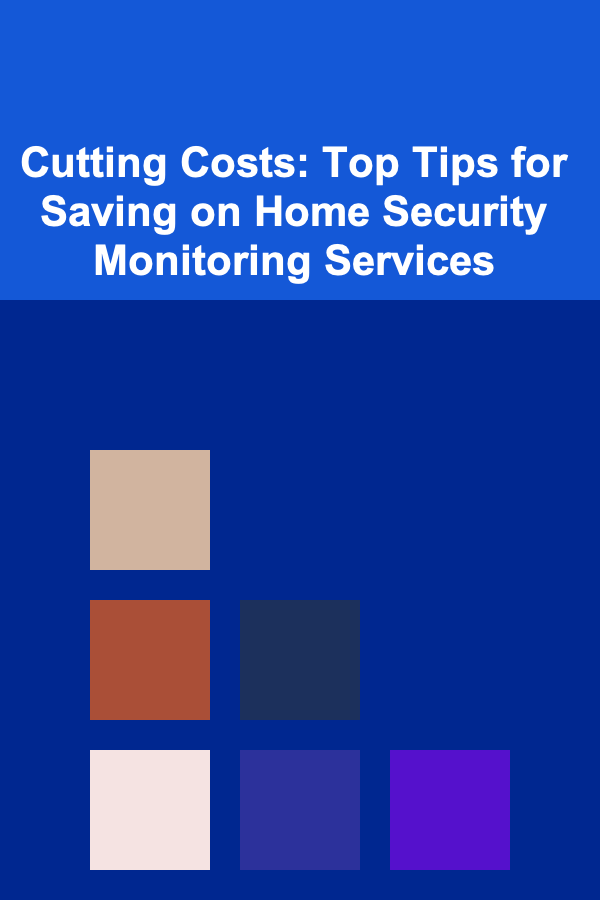
Cutting Costs: Top Tips for Saving on Home Security Monitoring Services
ebook include PDF & Audio bundle (Micro Guide)
$12.99$5.99
Limited Time Offer! Order within the next:

Home security is a top priority for many homeowners, offering peace of mind and protection against potential threats. However, one aspect of home security that can add up quickly is the cost of monitoring services. Traditional home security systems often come with high monthly fees, which may feel unnecessary for some homeowners, especially if they want to cut back on expenses without sacrificing safety.
The good news is that there are several effective strategies to reduce the cost of home security monitoring while maintaining adequate protection for your home and family. In this guide, we will walk through actionable tips that will help you save money on monitoring services, from exploring DIY options to negotiating with your provider, and everything in between.
Evaluate Your Home Security Needs
Before making any decisions on home security monitoring, it's crucial to assess your specific needs. Some homeowners may require full 24/7 monitoring with immediate emergency response, while others might only need to monitor motion or door/window sensors during certain hours. By understanding your requirements, you can determine the level of monitoring that's necessary, which will help avoid paying for unnecessary services.
Key Considerations:
- How vulnerable is your home? If you live in a low-crime area, you may not need the most expensive monitoring service.
- Do you need 24/7 monitoring? If you're home most of the time, you might only need monitoring during certain hours or days of the week.
- What's the size of your property? Larger homes may require more sensors and cameras, which can increase the cost of monitoring.
Once you've determined your exact needs, you'll be in a better position to select a cost-effective monitoring plan.
Consider DIY Home Security Systems
One of the most significant ways to reduce the cost of home security monitoring is to switch to a DIY system. Traditional monitoring services typically charge a high monthly fee for their services, but with DIY security systems, the upfront costs are often lower, and some allow you to self-monitor without paying a monthly fee.
Benefits of DIY Home Security:
- Lower Upfront Costs: Many DIY security systems are available for a fraction of the cost of traditional systems. You can buy the equipment outright and avoid ongoing fees.
- Self-Monitoring Options: Some DIY systems, like Ring, SimpliSafe, and Arlo, offer free self-monitoring. These systems allow you to receive alerts and notifications through your phone or computer, enabling you to monitor your home without paying for a third-party service.
- Customizable Plans: DIY systems give you the flexibility to add or remove sensors, cameras, or other equipment as needed, which can help you avoid paying for features you don't need.
However, while DIY systems can save money, they come with the responsibility of self-monitoring. This means you'll need to be proactive about responding to alerts and contacting authorities if necessary.
Switch to a Basic Monitoring Plan
Many traditional home security companies offer tiered service plans, with the most expensive plans including features like 24/7 professional monitoring, video surveillance, and immediate emergency response. However, you may not need all these features. Switching to a more basic plan can help reduce your monthly costs.
What to Look for in a Basic Plan:
- Essential Monitoring: Ensure that the plan includes essential monitoring services such as door/window sensors, motion detection, and alarm systems.
- Reduced Response Time: Some lower-tier plans still offer monitoring, but may have a slightly delayed response time. If you're comfortable with this, it could be an option for reducing costs.
- No Video Surveillance: If video monitoring isn't necessary for your security needs, consider opting for a plan that excludes video surveillance, as this feature can significantly raise the cost of monitoring.
Evaluate the features offered by different providers and choose a plan that fits your budget while still meeting your security needs.
Negotiate with Your Current Security Provider
If you've been with the same home security provider for some time, you might have more negotiating power than you think. Many security companies are willing to reduce rates to retain loyal customers or match offers from competitors.
Negotiation Tips:
- Research Competitors: Start by comparing prices from other providers in your area. If another company offers a better price or plan, use this as leverage when negotiating with your current provider.
- Highlight Your Loyalty: If you've been a customer for several years, point this out when discussing price adjustments. Many companies value long-term customers and may offer discounts to keep you.
- Ask for Bundled Services: Some companies offer discounts when you bundle home security with other services, like home automation or internet services. It's worth asking if there are any package deals that can help lower your monthly bill.
Remember that even if a provider is unwilling to drop the price, they may be willing to offer additional services or upgrades at no extra charge, which can add value without increasing your overall cost.
Explore Alternative Monitoring Services
While traditional home security companies like ADT, Vivint, and Frontpoint are widely known, there are many smaller, lesser-known providers that offer high-quality monitoring at a fraction of the cost. Exploring these alternative providers can help you find a more affordable solution without sacrificing security.
Alternatives to Traditional Monitoring:
- Alarm.com : Alarm.com partners with various service providers to offer customizable, affordable home security systems with remote monitoring capabilities.
- Cove Security: Cove offers simple, no-contract home security systems with affordable monitoring plans, starting as low as $14.99 per month.
- Ring Alarm: Ring offers an affordable DIY home security system with optional monitoring starting at $10 per month. It also integrates with other Ring devices like doorbells and cameras.
These alternative providers may offer similar monitoring services to the big names but at much lower monthly fees, so be sure to do your research to find the best deal.
Look for Discounts and Promotions
Home security providers often run promotions or discounts, especially for new customers. If you're willing to shop around or wait for a promotion, you can take advantage of special pricing to reduce your initial investment or monthly costs.
Where to Find Discounts:
- Holiday Sales: Look for discounts during major shopping events like Black Friday, Cyber Monday, or the New Year. Many security companies offer special deals during these times.
- Referral Programs: Some companies offer discounts if you refer a friend who signs up for their service. If you know someone who's looking for security monitoring, you can both benefit from these referral programs.
- Military and Senior Discounts: Some security providers offer discounts to military personnel, seniors, or first responders. If you qualify, this can be an easy way to save on your monitoring fees.
Be proactive in searching for these deals, as they can help you save a significant amount of money on your home security service.
Consider Mobile or App-Based Monitoring
Mobile app-based monitoring is becoming increasingly popular as an alternative to traditional security monitoring services. Instead of relying on a third-party monitoring center, you can monitor your home via an app on your smartphone. These services often cost less because they don't involve professional monitoring, and they give you greater control over your security system.
Popular Mobile-Based Monitoring Systems:
- Nest Secure: Google's Nest Secure allows for self-monitoring through an app, providing security alerts and notifications directly to your phone.
- Wyze Home Monitoring: Wyze offers an affordable DIY security system with optional professional monitoring for just $5 per month.
- Ring Alarm: As mentioned earlier, Ring also offers mobile-based monitoring with affordable optional professional monitoring.
These app-based systems allow you to save on monthly monitoring fees and provide you with greater flexibility in terms of monitoring schedules and devices.
Reduce Equipment and Service Fees
Another way to cut costs is by reducing the equipment and service fees associated with your security system. Some security providers offer deals where you can purchase equipment outright or waive installation fees if you handle setup yourself.
How to Save on Equipment:
- Buy Your Own Equipment: Some monitoring services allow you to use third-party equipment instead of their proprietary systems. Research compatible equipment options to avoid paying inflated prices for branded hardware.
- Install It Yourself: Many security companies charge installation fees, especially for systems that require professional setup. If you're comfortable with the installation process, consider doing it yourself to avoid paying extra.
- Opt for a Basic Package: Providers often offer equipment packages, but these can be expensive. Consider starting with a basic package and then adding extra devices as necessary, rather than buying a premium package upfront.
By reducing equipment and installation fees, you can further lower your overall costs while still maintaining a secure home.
Conclusion
Cutting costs on home security monitoring doesn't mean compromising on safety. By carefully evaluating your needs, considering DIY options, negotiating with your provider, exploring alternative services, and taking advantage of discounts and promotions, you can significantly reduce the expense of home security monitoring without sacrificing your home's protection.
With a little effort and research, you can secure your home affordably, ensuring peace of mind for you and your family.
Reading More From Our Other Websites
- [Home Cleaning 101] How to Clean Upholstery Without Damaging It
- [Organization Tip 101] How to Organize Your Luxury Event Planning Materials
- [Home Space Saving 101] How to Create an Efficient Laundry Space in Limited Room
- [Scrapbooking Tip 101] Scrapbooking Glues Reviewed: From Acid-Free to Waterproof
- [Organization Tip 101] How to Create a Cozy and Organized Home Office Nook
- [Screen Printing Tip 101] Common Screen Printing Mistakes on T-Shirts
- [Home Pet Care 101] How to Set Up a Pet-Friendly Outdoor Space in Your Backyard
- [Home Budget 101] How to Use Coupons and Discounts to Stretch Your Home Budget Further
- [Organization Tip 101] How to Maintain a Tidy Home During Busy Weeks
- [Metal Stamping Tip 101] Material Matters: Selecting the Right Alloys for Stamped Fasteners

How to Evaluate and Choose the Right Investment Portfolio
Read More
How to Use Festive Fabrics to Bring Holiday Cheer to Your Living Room
Read More
How To Ace Panel Interviews
Read More
How to Design a Creative Geocaching Adventure
Read More
10 Tips for Dealing with Difficult Patients as a Pharmacy Technician
Read More
10 Tips for a Minimalist Grocery Budget Checklist
Read MoreOther Products

How to Evaluate and Choose the Right Investment Portfolio
Read More
How to Use Festive Fabrics to Bring Holiday Cheer to Your Living Room
Read More
How To Ace Panel Interviews
Read More
How to Design a Creative Geocaching Adventure
Read More
10 Tips for Dealing with Difficult Patients as a Pharmacy Technician
Read More